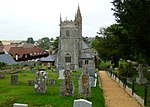Great Dorset Steam Fair

The Great Dorset Steam Fair (abbreviated GDSF, and since 2010 also known as The National Heritage Show) is an annual show featuring steam-powered vehicles and machinery. It now covers 600 acres (2.4 km2) and runs for five days. This used to be from the Wednesday after the UK August bank holiday, but from 2016 has been from the Thursday before the Bank Holiday until the Bank Holiday itself. It is reputedly the largest collection of steam and vintage equipment to be seen anywhere in the world. The fair was founded by the Dorset Steam & Historic Vehicle Club, and has been held in Dorset, England, every summer since 1969. The show is now organised by Michael Oliver's son, Martin Oliver, through Great Dorset Steam Fair Ltd.
Excerpt from the Wikipedia article Great Dorset Steam Fair (License: CC BY-SA 3.0, Authors, Images).Great Dorset Steam Fair
Salisbury Road,
Geographical coordinates (GPS) Address Nearby Places Show on map
Geographical coordinates (GPS)
| Latitude | Longitude |
|---|---|
| N 50.889722222222 ° | E -2.0994444444444 ° |
Address
Great Dorset Steam Fair (Site Of)
Salisbury Road
DT11 8HX
England, United Kingdom
Open on Google Maps









